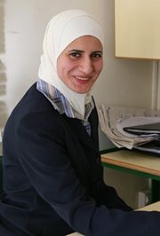
Women in Jordan
Encyclopedia

Milieu
Milieu is the word for environment in French, and, for hundreds of years, also in Dutch, Swedish, English, and other languages that were strongly influenced by French culture and French language, primarily during the 17th and 18th centuries....
, the number of women working outside the home increased in the 1980s. Women formed a little over 12 percent of the labor force in 1985. Many poor and lower-class women worked out of economic necessity, but a substantial number of working women came from financially secure families. According to the Ministry of Planning, the proportion of women working in professional and technical jobs was high. In 1985 women constituted 35.4 percent of technical workers and 36.1 percent of clerical staff. Women were least represented in agriculture and production. Women's increased access to education had led them to greater aspirations to work outside the home. Moreover, inflation had made the dual-income family a necessity in many cases.
Jordanian women served as a reserve labor force and were encouraged to work during the years of labor shortages when economic expansion and development plans were high on the government's priority list. In a 1988 study of women and work in Jordan, journalist Nadia Hijab
Nadia Hijab
Nadia Hijab is a prominent Palestinian political analyst, author and journalist who comments frequently on human rights and the Middle East, and the situation of the Palestinians in particular.-Biography:...
argued that cultural attitudes were not the major constraint on women's employment; rather, need and opportunity were more significant factors.
Most employed women were single. Unmarried women, in particular, were initially considered a source of untapped labor. Yet cultural constraints clearly militated against women working in agriculture, industry, and construction—areas of low prestige, but also the sections with the most critical labor shortages. Development programs for women focused on technical training. Hijab mentions that a typical project was "to train women on the maintenance and repair of household appliances."
To make work more attractive to women with children, the government discussed amending the labor laws to improve conditions. Such proposed amendments included granting more maternity leave and providing day-care facilities at the workplace. In addition, the media encouraged a more liberal attitude to women's working. Women's employment gained further legitimacy through national ceremonies sponsored by the government and the royal family honoring women's work.
The critical years of labor shortages were 1973 to 1981. By the mid-1980s, the situation had changed as unemployment surged. With high unemployment, women were asked to return to their homes. Publicly and privately, Jordanians hotly debate whether women should work. Letters to the editors of daily newspapers argued for and against women's working. Some government leaders had decided that women should return to their homes. Discussion about amending labor laws was shelved, and Hijab observed that by 1985 there was "almost an official policy" to encourage married women to stay at home. Then Prime Minister Zaid ar Rifai bluntly suggested in 1985 that working women who paid half or more of their salary to foreign maids who sent the currency abroad should stop working.
Differences in attitude towards women's employment frequently were based on the conditions of work. In a study of attitudes toward women and work, Jordanian sociologist Mohammad Barhoum found that resistance was least to women working in traditionally female occupations such as teaching, nursing, and secretarial work. He believed the change in attitude resulted from increased educational opportunities for girls and their parents' realization that education was as important for girls as for boys, especially in the event of widowhood or divorce. The erosion of male wages, no longer adequate to support a family, had also been a prominent factor in legitimizing female employment.
The impact of women's employment on relations within the family remained difficult to assess in 1989. Employment and contribution to family income accorded women a greater voice in family matters. The traditional division of labor between men and women within the family often remained relatively untouched when women worked. Women's work at home was often taken up by other women rather than shared between men and women. Women earning lower incomes relied on their extended network of female relatives to help with child care and housework, while upper and middle income women hired maids (usually foreigners from the Philippines
Philippines
The Philippines , officially known as the Republic of the Philippines , is a country in Southeast Asia in the western Pacific Ocean. To its north across the Luzon Strait lies Taiwan. West across the South China Sea sits Vietnam...
, Sri Lanka
Sri Lanka
Sri Lanka, officially the Democratic Socialist Republic of Sri Lanka is a country off the southern coast of the Indian subcontinent. Known until 1972 as Ceylon , Sri Lanka is an island surrounded by the Indian Ocean, the Gulf of Mannar and the Palk Strait, and lies in the vicinity of India and the...
, or Egypt
Egypt
Egypt , officially the Arab Republic of Egypt, Arabic: , is a country mainly in North Africa, with the Sinai Peninsula forming a land bridge in Southwest Asia. Egypt is thus a transcontinental country, and a major power in Africa, the Mediterranean Basin, the Middle East and the Muslim world...
) to tend to their homes, husbands and children.

